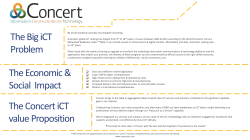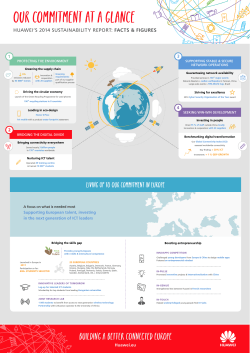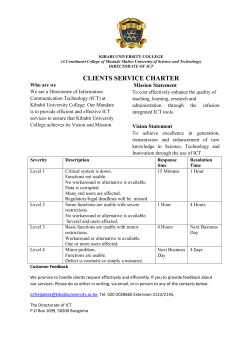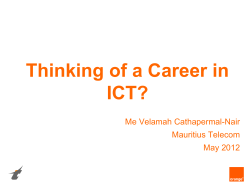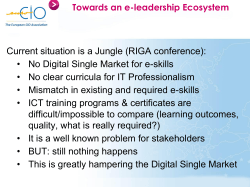
The World Telecommunications / ICT Indicators Symposium (WTIS)
TRAAC Paper No. 4/2015 The 12th ITU World Telecommunication / ICT Indicators Symposium (WTIS) Telecommunications Regulatory Affairs Advisory Committee 21 April 2015 Purpose • To brief Members about – The latest world ranking on the latest information and communication technology (ICT) Development Index – Hong Kong’s position on the International Telecommunication Union (ITU) “Measuring the Information Society Report” – Latest development and future of ICT measurement 2 12th WTIS • Annual event organised by the Telecommunication Development Bureau (BDT) of the ITU • Hosted in Tbilisi, Georgia on 24-26 November 2014 • Attended by 250 participants from 79 Member States, 15 public and private organisations and other international organizations • A major international forum to discuss international ICT development • The “Measuring the Information Society Report 2014” was launched in the event Free version of the report available from http://www.itu.int/en/ITU-D/Statistics/Pages/publications/mis2014.aspx 3 ICT Development Index (IDI) • A composite index combining 11 indicators into one benchmark to monitor and compare developments in ICT across countries • Main objectives of the IDI are to measure countries with regard to: – Progress in ICT development – The digital divide between countries in terms of ICT development – The development potential of ICTs or extent to which countries can make use of ICTs to enhance growth and development 4 – No. 1 Denmark followed by Korea • Hong Kong ranked 9th globally and 2nd in Asia • Most of the top ten performers are in Europe Hong Kong, China 9 8.28 11 8.08 Luxembourg Japan Australia Switzerland United States Monaco Singapore Germany France New Zealand Andorra Estonia Macao, China Canada Austria Belgium 10 11 12 13 14 15 16 17 18 19 20 21 22 23 24 25 8.26 8.22 8.18 8.11 8.02 7.93 7.90 7.90 7.87 7.82 7.73 7.68 7.66 7.62 7.62 7.57 9 10 12 13 14 17 15 18 16 19 24 21 20 25 23 26 8.19 8.15 8.03 7.94 7.90 7.72 7.85 7.72 7.73 7.62 7.41 7.54 7.59 7.37 7.46 7.33 China 86 4.64 86 4.39 Ethiopia Eritea Chad Niger Central African Rep. 162 163 164 165 166 1.31 1.20 1.11 1.03 0.96 162 163 164 165 166 1.24 1.18 1.09 0.97 0.93 Rank 2 1 3 4 7 6 5 8 2012 Score 8.78 8.81 8.68 8.58 8.28 8.35 8.36 8.27 … • Ranked 166 countries or economies globally 2013 Score 8.86 8.85 8.67 8.64 8.50 8.39 8.38 8.31 … Top IDI Countries Rank 1 2 3 4 5 6 7 8 Economy Denmark Korea (Rep.) Sweden Iceland United Kingdom Norway Netherlands Finland 5 ICT Development Index (IDI) • The IDI combined 11 indicators in three categories – ICT access – ICT use – ICT skills • Selection of individual indicators based on: – relevance – data availability and quality – results of various statistical analysis (also determined the weighting of the indicators) ICT Access % 1. Fixed-telephone subscriptions per 100 inhabitants 20 2. Mobile-cellular telephone subscriptions per 100 inhabitants 20 3. International Internet bandwidth (bit/s) per Internet user 20 4. Percentage of households with a computer 20 5. Percentage of households with Internet access 20 ICT Use % 6. Percentage of individuals using the Internet 33 7. Fixed (wired)-broadband subscriptions per 100 inhabitants 33 8. Wireless-broadband subscriptions per 100 inhabitants 33 ICT Skills % 9. Adult literacy rate 33 10. Secondary gross enrolment ratio 33 11. Tertiary gross enrolment ratio 33 Weights 40% Weights 40% Weights 20% 6 ICT Access Economy Luxembourg Switzerland Iceland • Hong Kong ranked 4th on this category and continually strong in this category • Measured by : Fixed line per 100 inhabitant Mobile per 100 inhabitant International Internet bandwidth per user (Bit/s) % of households with computers % of households with Internet 5 6 7 8 9 10 9.19 9.18 8.98 8.94 8.93 8.93 4 7 5 10 9 6 8 9.16 8.61 8.40 12 15 8.53 8.26 7.88 24 7.90 5.10 91 4.78 8.99 9.10 8.88 8.91 9.02 8.95 … Fixed per 100 inhabitants Mobile per 100 inhabitants International Internet bandwidth per Internet users % of households with computers % of households with Internet access 2007 9.24 13 14 … Singapore Japan Macao, China 25 … – – Germany United Kingdom Malta Korea (Rep.) Sweden Netherlands 4 China 89 … – – – Hong Kong, China 2013 2012 Rank Score Rank Score 1 9.46 1 9.40 2 9.36 3 9.30 3 9.28 2 9.31 2008 2010 2011 2012 2013 59.4 154.7 60.4 167.2 61.8 195.6 61.0 214.7 61.3 229.2 63.0 238.7 483383 465650 776625 1079661 1424597 1762774 74.0 70.1 74.6 70.9 77.9 76.4 79.1 77.5 80.0 77.9 81.9 79.9 7 – … Hong Kong, China 13 7.36 14 6.93 Singapore 15 7.19 13 7.14 Macao, China 18 7.01 16 6.81 2.99 72 2.68 … – Percentage of individuals using the Internet Fixed (wired) broadband subscriptions per 100 inhabitants Wireless-broadband subscriptions per 100 inhabitants China 77 … – … • Hong Kong ranked 13th on this category • Measured by : Economy Denmark Sweden Korea (Rep.) Finland Norway United Kingdom Japan Luxembourg Iceland United States 2013 2012 Rank Score Rank Score 1 8.71 1 8.47 2 8.29 2 8.22 3 8.26 3 8.20 4 8.09 4 8.01 5 8.07 5 7.99 6 7.88 9 7.39 7 7.80 6 7.78 8 7.66 7 7.54 9 7.65 8 7.47 10 7.50 11 7.21 … ICT Use Internet users per 100 inhabitants Fixed broadband per 100 inhabitants Mobile broadband per 100 inhabitants 2007 65.0 27.3 31.6 2008 66.7 28.3 40.3 2010 72.0 29.9 38.9 2011 72.2 31.6 74.5 2012 72.9 31.2 83.2 2013 74.2 30.8 95.4 8 ICT Skills Economy Greece Korea (Rep.) Finland Belarus United States Australia Slovenia Andorra Spain Iceland • Hong Kong ranked 50th on this category • Measured by : … Adult literacy rate Secondary gross enrolment ratio Tertiary gross enrolment ratio Japan 32 8.67 32 8.67 8.53 40 8.53 8.24 50 8.24 7.9 59 7.9 7.02 84 7.02 … – – – 2013 2012 Rank Score Rank Score 1 9.90 1 9.90 2 9.81 2 9.81 3 9.75 3 9.75 4 9.69 4 9.69 5 9.56 5 9.56 6 9.50 6 9.50 7 9.43 7 9.43 8 9.41 8 9.41 9 9.41 9 9.41 10 9.32 10 9.32 • Basically remained stable in the last 5 years 40 … Macao, China 50 … Hong Kong, China 59 … Singapore 84 … China Secondary Enrolment Ratio Tertiary Enrolment Ratio Adult Literacy Rate 2007 83.1 34.3 99.0 2008 82.9 55.6 99.0 2010 83.0 59.7 99.0 2011 80.1 60.4 99.0 2012 88.7 59.7 99.0 2013 88.7 59.7 99.0 9 Future of ICT Indicators – Big Data • “Big Data” is the digital footprints generated from data flows – Collective network activities – Data traffic patterns – Traces of data left behind from using ICT • Great promises – Proliferation of mobile internet and portable devices – Potential being explored by United Nations Statistics Commission (UNSC), World Bank, and national statistics organizations (NSOs) – ITU is suggesting members to explore big data’s potential 10 Potential of Big Data • Complementing official statistics – Since official statistics focused on the supply side – Broader data produced (Variety, Velocity, Volume, Value, Veracity) • Providing timely and relevant evidence for policy making as well as for private sectors • Examples of using big data to solve social and economic issues – Mobile phone data analysis in tracking human mobility and the spread of Ebola pandamic1 – Roaming-in mobile data analysis in understanding tourist visit patterns in the Netherlands Note 1: Using Big Data To Fight Pandemics (Telefonica Research) http://www.itu.int/en/ITU-D/Statistics/Documents/events/wtis2014/004_E_doc.pdf http://techcrunch.com/2014/11/08/using-big-data-to-fight-pandemics/ 11 Detailed Example of using Big Data • Roaming-in mobile data analysis in the Netherlands2 – Statistics Netherlands innovation on tourism statistics through the use of big data sources supplied from mobile operators – Based on the no. of connections made to which cell towers, at what time and by differentiating local users and inbound roamers – Could analyse on the number of visiting tourist, their travel patterns and their origins – To ensure anonymity: data are aggregated; devices are only assigned with temporary ID no. and are entrusted only by vigorous measures Note 2: Innovation of tourism statistics through the use of new big data sources (Statistics Netherlands 2014) http://www.itu.int/en/ITU-D/Statistics/Documents/events/wtis2014/002INF-E.pdf 12 Detailed Example of using Big Data (2) Roaming data for Asian (left) and Belgium (right) tourists (devices) from 12:00 – 16:00 hrs. on 11 January Roaming from Asia Roaming from Belgium 13 Challenges in using Big Data • Privacy – Use and disclosure of customer information by telecommunications service providers are subject to the Personal Data (Privacy) Ordinance (PDPO) and the telecommunications licence conditions – The intended use of personal data likely exceeds any consent given by the customers in their telecommunications service agreements – Data aggregation and anonymization may not be able to satisfy the social requirement on privacy • Security – Possibility in disclosure of sensitive information when one source is combined with data from other sources • Standardisation – 85% of big data are estimated to be un-structured – Interoperability issues • Continuity and data preservation – volume of data is overwhelming – Small incentives and coordination in large scale sharing or pooling of data 14 Way Forward • Statistics – OFCA will continue the close collaboration with ITU in providing statistics on the telecommunications industry – Requirements on data will be reviewed by ITU continuously. We will monitor the changes and revert to the industry. – We may explore with the industry on the possibility in obtaining new statistics to take into account future trends – We will continue disseminating key telecommunications indicators in OFCA’s website ( www.ofca.gov.hk/en/media_focus/data_statistics/index.html ) • Big Data – ITU will explore ways in collecting big data for statistics studies – OFCA will keep in view the development in relation to collection and use of big data 15 Thank you 16
© Copyright 2025


